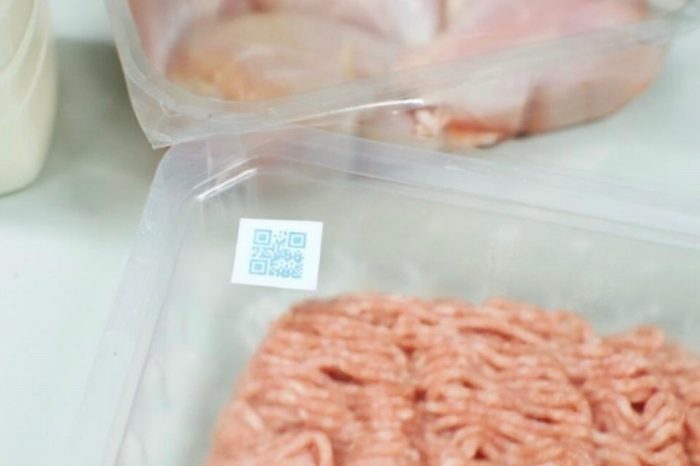Associate Professor Rona Chandrawati
Empowering smarter food consumption with sensors

Through the development of polymer sensors that detect food spoilage in real time, Associate Professor Rona Chandrawati and her team at UNSW are changing the way we consume and dispose of everyday foods. As the country’s leading researcher in colourimetric polymer sensor technology, A/Prof. Chandrawati has spent the last seven years developing these nano sensors to help reduce food wastage, decrease foodborne illnesses and ensure access to safe food for everyone.
Many of us rely on the ‘best before date’ when consuming food. This guide however is simply an indication – and often leads to significant amounts of food waste. To solve this problem, A/Prof. Chandrawati and her team have developed highly sensitive nano sensors that react to compounds generated by food that’s gone bad. These sensors are brought to life in the form of a sticker that is attached to food packaging. Once spoilage occurs, the sticker’s polymer sensor reacts with the gasses produced by spoilage, and changes colour from blue to red.
"The sensors aren’t meant to replace the best before date but to compliment it. To help us make better decisions about whether we throw out food or consume it.”
- A/Prof. Chandrawati
This technology allows consumers to monitor food quality at home without the need for specialised equipment. “The idea is, if it turns red, it’s obvious that your food has spoiled,” adds A/Prof Chandrawati. “Once that happens, the colour won’t change back so there’s no false negative.”
Currently, A/Prof. Chandrawati and her team are working with meat products but this sensor technology also has the potential to monitor fruit ripening and milk spoilage. “We’re starting with meat because when it spoils and we consume it, we get really sick,” she explains.
Challenges and opportunities
Despite the successful application of the technology, there are still challenges to the research including the way in which food – in particular meat – is grown and how this impacts the spoilage process. “Food that comes from different producers and regions has a different composition, and if the food is different, the gas composition is different,” says A/Prof. Chandrawati. “We don’t want the colour to change when the food isn’t spoilt or the spoilage isn’t accurate.”
To continue developing the technology, A/Prof. Chandrawati works with a team of postdoctoral researchers, PhD students, and undergraduate students with multidisciplinary expertise across chemical engineering, materials chemistry, and food science. “Everyone is working on different aspects of the project,” she explains. “From identifying the gas to working out how we might be able to connect the sensors with traceability and blockchain in the future.”
UNSW’s A/Prof Chandrawati and her team of researchers who are working on colourimetric sensors to reduce food spoilage.
This would allow for the use of the technology to help trace instances of wide-spread food contamination. “We hear a lot about food being recalled because of contamination,” she explains. “By tracking the journey of a food product, we could extract information about where a contamination outbreak has come from, where it’s travelled through, and help supermarkets understand which batches of product should be disposed of and which are OK.”
This work is being done in collaboration with industry partner, FP Paradigm, supported by the Future Food Systems CRC. “FP Paradigm is proud to collaborate with A/Prof Chandrawati to help address the food waste issue not only in Australia but around the world,” says Director, Eduard Alcordo. “We can see that the colourimetric sensor technology being developed will have a major impact reducing food waste in the industry. Together, we are working hard on developing this further and to execute its implementation in the market.”
Importantly, the innovative sensor technology isn’t just effective, it’s affordable.
“Based on the lab process, we expect it to be a very low cost per unit. If this process is produced at large scale, you’d be able to bring the cost down even further.”
- A/Prof. Chandrawati
A/Prof. Chandrawati has a vision of the colourimetric sensors being used in supermarkets around the world.
Future focused
Through the use of A/Prof. Chandrawati’s sensor technology, consumers and industries will be able to positively impact food management and production. “Food production requires a lot of resources like land, water and agriculture, and at the same time, the earth’s population is expected to grow to 7 billion by 2050 yet with the same land area,” adds A/Prof. Chandrawati.
“So, it’s really about making the most of the food we already have and wasting less so we’re not further contributing to climate change through the methane gas emissions from landfilled food waste.”
- A/Prof. Chandrawati.
Beyond the current impact of her work, A/Prof. Chandrawati believes her easy-to-read sensors might open doors to additional applications such as target compounds in health, agriculture and the environment. For now, she’s most excited about eventually seeing her sensors appear in supermarkets throughout the country and around the globe. “We hope to see it… it might be in 5-10 years but that’s our big vision.”
Share this story
Health
Read more
Get in touch and see what’s possible.
Ask how we can help your business, industry, or market through collaboration.

.cropimg.width=700.crop=basic.jpg)




